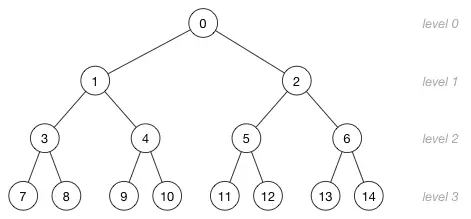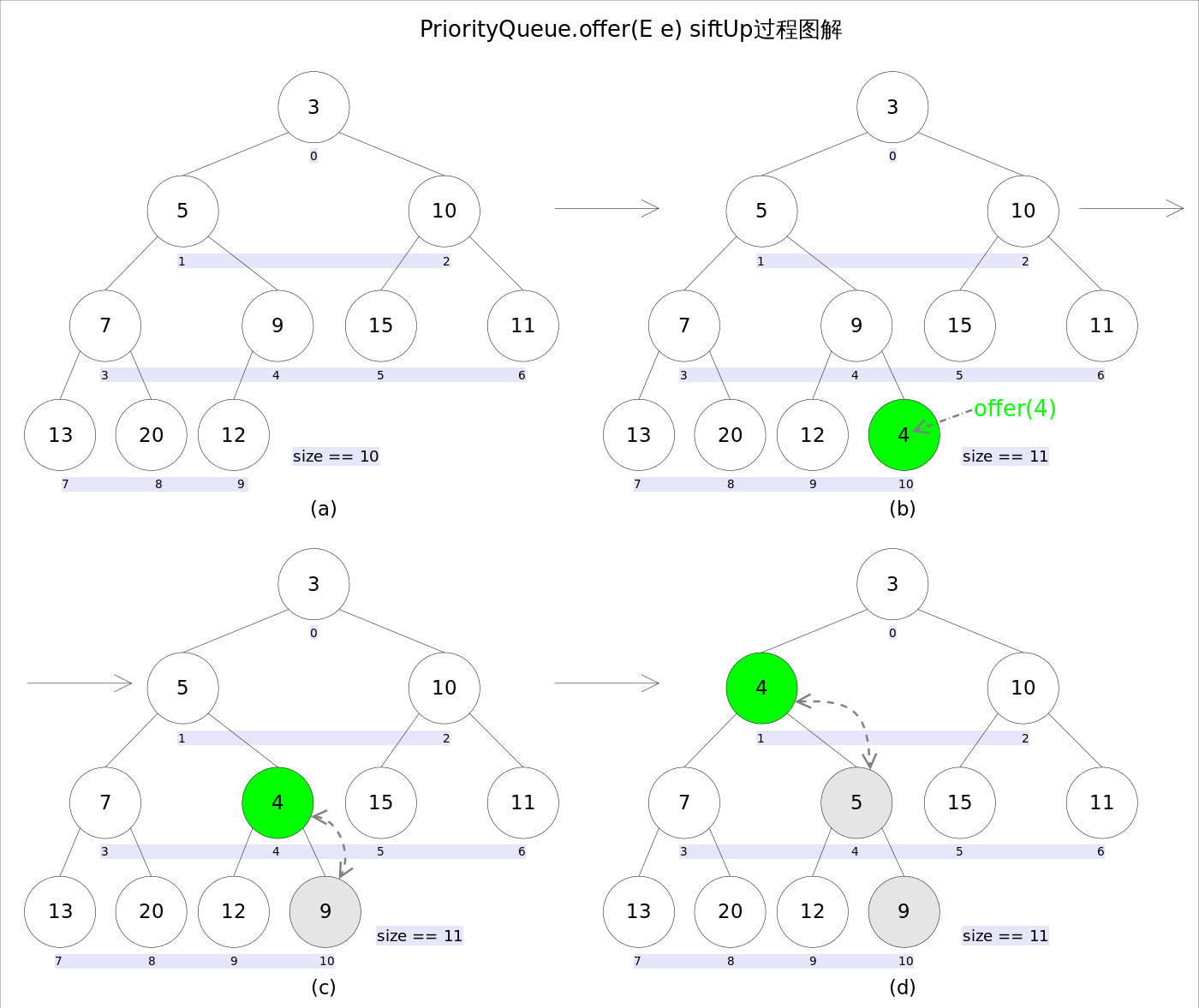前言
LeetCode 上有一道很经典的算法题,数据流中的中位数,题目描述很简单,就是让你得到中位数,比如 [1, 2, 3] 的中位数就是 3,[1, 2, 3, 4] 的中位数就是 (2 + 3) / 2 = 2.5,解法也有很多,比如最简单的,直接维护一个有序数组,每次插入数据时就让对应位置后方的数据全部后移一位然后插入。
但是这样的方法显然十分低效,我们只关心中位数,而其他部分实际上根本不需要保持有序。观察题目要求,假设使用数组数据结构,中位数实际上是把数组分成了等长的两部分,左边的部分都小于它,右边的部分都大于它(偶数个时的中位数是通过计算得到的)。那么问题就十分明了了,我们如果可以维护两个数组,其中一个只维护最大值,另一个只维护最小值,不就可以很轻松地得到中位数了吗。
这种数据结构就是 堆(Heap)
正文
堆
堆是一颗 完全二叉树,且节点的值一定不大于(或不小于)其子节点的值。
如果节点的值都大于其子节点,则成为 大顶堆/大根堆(max-heap)
反之就是 小顶堆/小根堆(min-heap)
如下图就是一个小根堆:

由于堆是一个完全二叉树,所以我们完全可以使用数组来存储,而且节点满足以下规律:
若当前节点下标为 x,则有
- 当前节点的左节点下标为
2x+1
- 当前节点的右节点下标为
2x+2
利用堆的这些性质,再给它加上插入和删除等方法,我们就得到了一个新的数据结构:优先队列
优先队列
插入(push)
优先队列的插入大致分为如下几个流程:
- 把节点插入到堆的最后
- 将插入节点与父节点作比较,判断是否满足大小关系
- 如果不满足则交换父节点和插入节点,然后继续重复比较,直到满足大小关系
这样的一个流程被称为 上浮(shiftUp),小根堆的插入流程大致如下图所示:

弹出(pop)
优先队列的弹出操作指将根节点移出队列,对于小根堆就是弹出队列中的最小值,对于大根堆就是弹出队列中的最大值
弹出操作的流程有点类似于插入操作的逆操作,流程大致如下:
- 将根节点与堆的最后一个节点调换位置
- 将堆的最后一个节点移出,即对堆的数组调用
pop 方法
- 从根节点出发,将其与子节点作比较,若不满足大小关系则与子节点交换
- 重复比较直至满足大小关系
这样的流程也被成为 下沉(poll) 操作,小根堆的弹出流程大致如下图所示:

代码实现
优先队列的有许多实例方法,例如 top、empty 等,以下是 TypeScript 的一个简单实现
1
2
3
4
5
6
7
8
9
10
11
12
13
14
15
16
17
18
19
20
21
22
23
24
25
26
27
28
29
30
31
32
33
34
35
36
37
38
39
40
41
42
43
44
45
46
47
48
49
50
51
52
53
54
55
56
57
58
59
60
61
62
63
64
65
66
67
68
69
70
71
72
73
74
75
76
77
78
79
80
81
82
|
export class PriorityQueue<T> {
private heap: T[]
/**
* 用于比较父节点和子节点的关系,返回值为 true 代表不满足要求需要交换节点
* 反之说明满足要求,不需要交换节点
* 例如 `parent < node` 时交换节点,说明大的节点在上,即大根堆
* @example
* (parent: number, node: number) => parent < node)
*/
private compareFn: (parent: T, child: T) => boolean
constructor(compareFn: (parent: T, child: T) => boolean) {
this.heap = []
this.compareFn = compareFn
}
// 获取队列长度
public size(): number {
return this.heap.length
}
// 判断队列是否为空
public isEmpty(): boolean {
return this.heap.length === 0
}
// 获取队头元素
public top(): T | undefined {
return this.heap[0]
}
// 入队操作
public push(item: T): void {
// heap.length 就是对应下一个节点的下标
let i = this.heap.length
let parentIndex: number
while (i !== 0) {
// 奇数,是左节点
if (i & 1) parentIndex = (i - 1) / 2
// 偶数,是右节点
else parentIndex = (i - 2) / 2
// 判断与根节点的关系
if (this.compareFn(this.heap[parentIndex], item)) {
this.heap[i] = this.heap[parentIndex]
i = parentIndex
} else break
}
this.heap[i] = item
}
// 出队操作
public pop(): T | undefined {
// 队列长度不超过 1 时,直接返回队头
if (this.heap.length <= 1) return this.heap.pop()
const res = this.heap[0]
this.heap[0] = this.heap.pop()!
// 从队头出发,调整队列
let i = 0
while (2 * i + 1 < this.heap.length || 2 * i + 2 < this.heap.length) {
// 左节点存在
if (
2 * i + 1 < this.heap.length &&
this.compareFn(this.heap[i], this.heap[2 * i + 1])
) {
// 不满足就交换
let temp = this.heap[i]
this.heap[i] = this.heap[2 * i + 1]
this.heap[2 * i + 1] = temp
i = 2 * i + 1
continue
}
// 右节点存在
if (
2 * i + 2 < this.heap.length &&
this.compareFn(this.heap[i], this.heap[2 * i + 2])
) {
// 不满足就交换
let temp = this.heap[i]
this.heap[i] = this.heap[2 * i + 2]
this.heap[2 * i + 2] = temp
i = 2 * i + 2
continue
}
break
}
return res
}
}
|
使用优先队列,我们再来解决一下开头提到的问题
获取中位数
我们这里使用优先队列 left 来记录数组的左半部分,使用 right 来记录数组的右半部分,我们需要维护这两个优先队列,使得 left 的长度要么与 right 相同,要么比它多 1
这里实际上对应着两者总长度为奇数和偶数的两种情况,总长为奇数时,中位数就是 left 的队头,偶数时则是两者队头的平均数,以下是详细的代码实现
代码实现
1
2
3
4
5
6
7
8
9
10
11
12
13
14
15
16
17
18
19
20
21
22
23
24
25
26
27
28
29
30
31
32
33
34
35
36
37
38
39
40
41
42
43
44
45
|
class MedianFinder {
// 用 left 保存较小的一半
public left: PriorityQueue<number>
// 用 right 保存较大的一半
public right: PriorityQueue<number>
/**
* 规定 left 的长度要么与 right 相同,要么比它多 1
* 这样,当总长度为奇数时,中位数就是 left 的堆顶
* 当总长度为偶数时,中位数就是 left 堆顶和 right 堆顶的平均值
*/
constructor() {
// 左边是大根堆 maxHeap
this.left = new PriorityQueue<number>((parent, node) => parent < node)
// 右边是小根堆 minHeap
this.right = new PriorityQueue<number>((parent, node) => parent > node)
}
addNum(num: number): void {
/**
* 分情况,如果 num < left.top() 说明这个数小于中位数,应当位于左边
* 那么就需要把当前的中位数加入 right 队列中,然后再把 num 入队 left
*/
if (num < this.left.top()!) {
this.right.push(this.left.pop()!)
this.left.push(num)
} // 反之说明这个数大于中位数,应当位于右边
else {
this.right.push(num)
// 此时需要检查 right 队列的长度
// 如果 right 超越了 left 的长度,则需要重新平衡
if (this.right.size() > this.left.size()) {
this.left.push(this.right.pop()!)
}
}
}
findMedian(): number {
if (this.left.size() > this.right.size()) {
// left 的长度长于 right 的长度,中位数就是 left 的队头
return this.left.top() ?? 0
}
return ((this.left.top() ?? 0) + (this.right.top() ?? 0)) / 2
}
}
|



